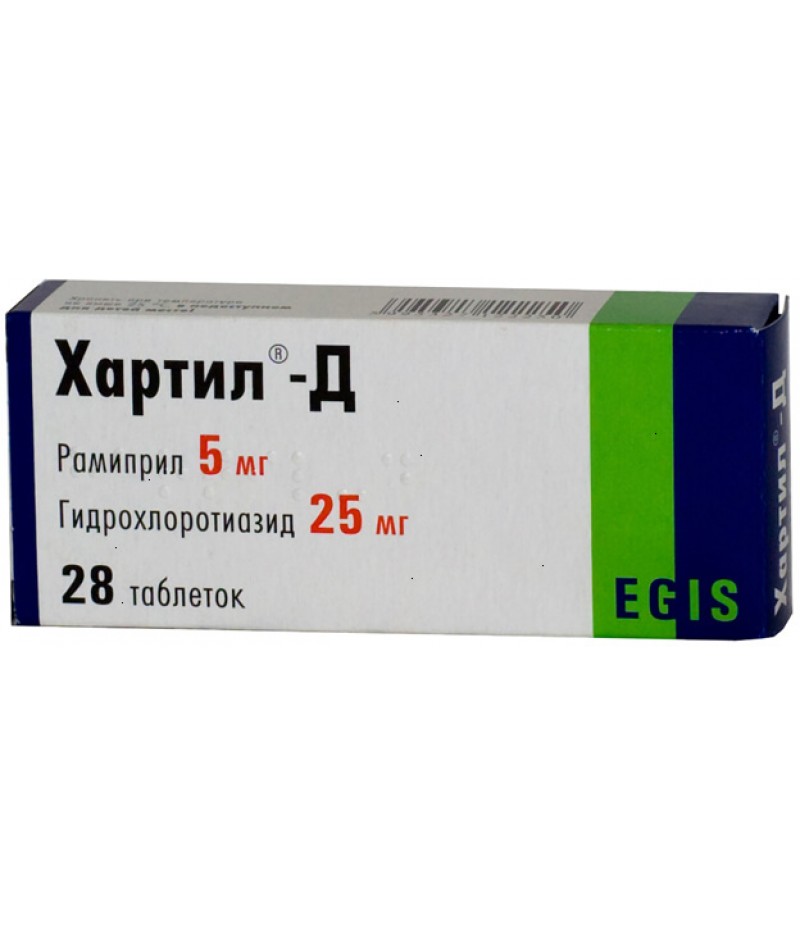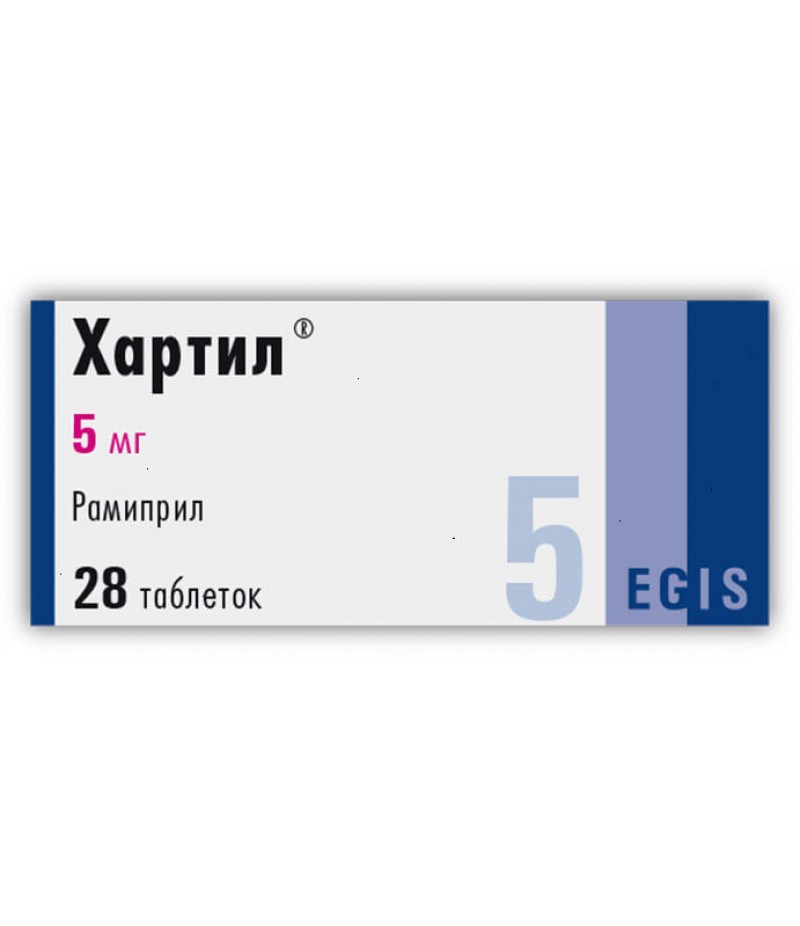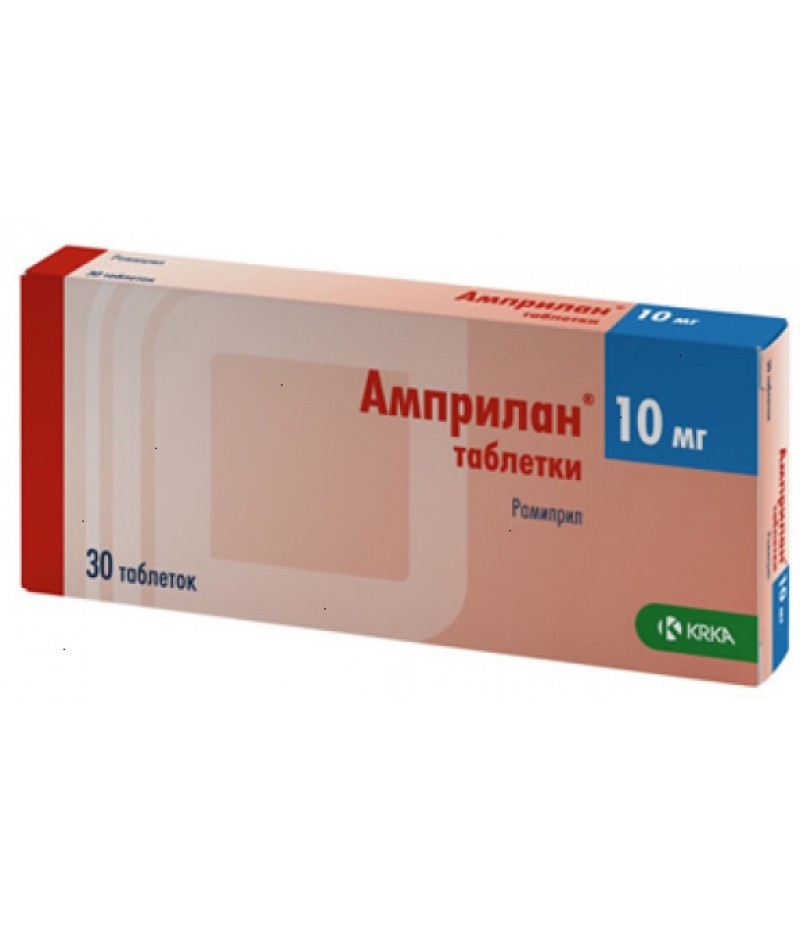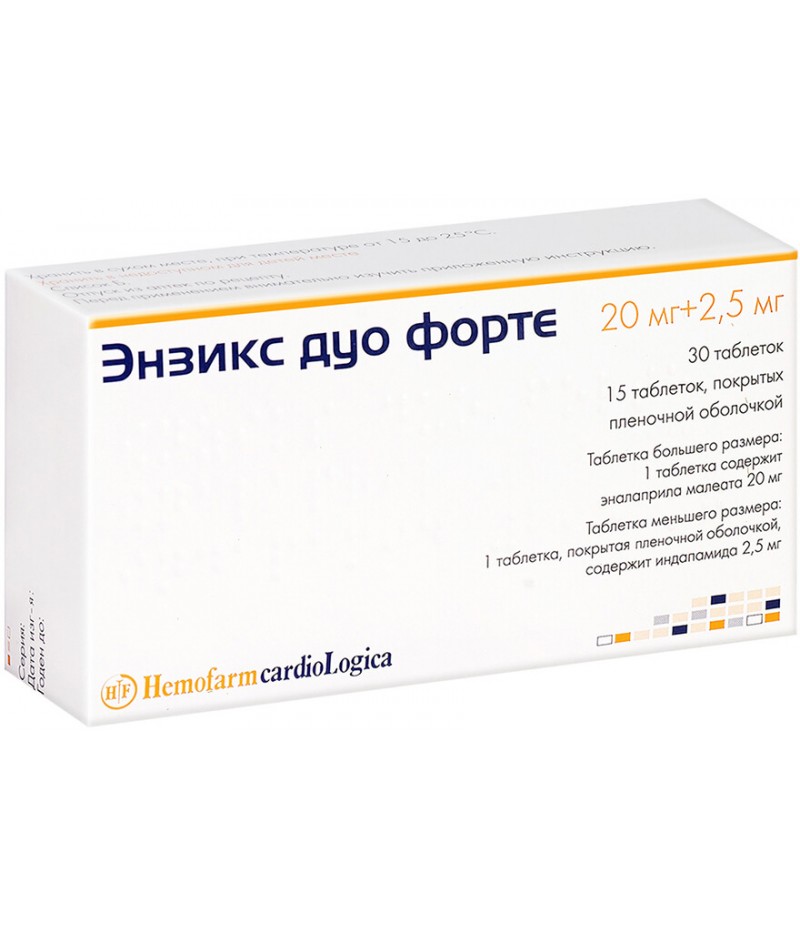Hartil-D 5mg + 25mg #28
- $39.64
- 3 or more $38.50
- Availability:In Stock
Hartil-D instruction for useTo buy Hartil-D just add it to your shopping cartCompositionThe active substances of the drug are ramipril and hydrochlorothiazide.Additional components: lactose monohydrate, crospovidone, sodium steary..
Tags: tabs
Hartil-D instruction for use
To buy Hartil-D just add it to your shopping cart
Composition
The active substances of the drug are ramipril and hydrochlorothiazide.
Additional components: lactose monohydrate, crospovidone, sodium stearyl fumarate, hypromellose, MCC.
Form of issue
The medicine is sold in tablets.
pharmachologic effect
Hartil-D is an antihypertensive drug that also has a diuretic effect. The antihypertensive effect of the active substances of the drug complements each other, while ramipril reduces the hypokalemic effect of hydrochlorothiazide.
Pharmacodynamics and pharmacokinetics
The active components of this remedy are used for hypertension.
Ramiprilate (an active metabolite of ramipril) inhibits ACE. In addition, it reduces the release of aldosterone. Ramipril also causes a decrease in peripheral vascular resistance.
In most cases, the antihypertensive effect is noticeable after 1-2 hours. It persists for 24 hours. The maximum degree of severity of action is reached after 3-6 hours. With prolonged therapy, the maximum effect is usually noticeable after about 3 weeks. With a long-term course of treatment, it is maintained for 2 years.
Hydrochlorothiazide is a thiazide diuretic. The possible nature of its antihypertensive action includes a change in sodium balance and resistance of renal vessels, as well as a decrease in the level of extracellular fluid, plasma and reactions to angiotensin II and noradrenaline.
The maximum effect is visible after 3-6 hours and lasts up to 12 hours. Antihypertensive action is achieved after 3-4 days of therapy and lasts a week after completion of the course. With long-term therapy, lowering blood pressure is achieved by using lower dosages than necessary for a diuretic effect. Reduction in blood pressure is accompanied by a slight increase in the rate of glomerular filtration, the activity of renin in the blood plasma, as well as vascular resistance of the renal bed. When hydrochlorothiazide is used in high dosages, the plasma volume decreases, as well as the glomerular filtration rate, mean arterial pressure and renal blood flow. With long-term therapy in small doses, the volume of blood plasma, systemic vascular resistance and mean arterial pressure remain rather low, while the glomerular filtration rate and minute volume return to the same parameters.
Indications for use
The medicine must be taken with arterial hypertension as a component of the combined treatment.
Contraindications
This tool is not recommended for use when:
cholestasis;
Quincke's edema in the anamnesis, as well as hereditary / idiopathic;
significant problems with kidney function;
anuria;
primary aldosteronism;
hemodialysis;
intolerance to galactose;
hereditary lactase deficiency or in violation of absorption of glucose-galactose;
breastfeeding;
pregnancy;
childhood;
significant violations in the work of the liver;
arterial hypotension;
condition after kidney transplantation;
intolerance to the components of the drug.
With care, Hartil-D is prescribed for aortic and mitral stenosis, systemic connective tissue diseases, severe lesions of the coronary and cerebral arteries, decompensated pulmonary heart, severe ventricular cardiac arrhythmias, oppression of bone marrow hematopoiesis, bilateral stenosis of the renal arteries, gout, hyponatremia, hypercalcemia , renal insufficiency, cirrhosis of the liver, unstable angina, chronic heart failure (fourth stage), lowering of bcc, diabetes, n residential aged, hypertrophic obstructive cardiomyopathy, hyperkalemia, stenosis of the artery only kidneys, hypokalemia, ischemic heart disease, liver failure.
Side effects
When taking the drug at the beginning of therapy and after increasing the dosage, arterial hypotension may appear. Symptoms such as dizziness, blurred vision, general weakness, fainting are possible. In addition, there are reports of isolated cases of dynamic disturbance of cerebral circulation, tachycardia, arrhythmias, myocardial infarction, palpitation, severe arterial hypertension, angina and shock. During the use of ACE inhibitors in arterial hypotension, cerebral hemorrhage and ischemic stroke are possible.
The following adverse reactions are also likely:
metabolism - hyperglycemia, increased acid levels, hypokalemia, gout, hyperkalemia, hypomagnesemia, hypercalcemia, hyponatremia, hyperchloremia;
nervous system - apathy, nervousness, headache, fatigue, sensation of weakness, drowsiness;
organs of vision - conjunctivitis, blepharitis;
cardiovascular system - a significant reduction in blood pressure, swelling of the ankles;
respiratory system - the appearance of dry cough, bronchitis;
digestive system - nausea, vomiting, abdominal pain, indigestion, epigastric spasms, constipation, dull appetite, thirst, diarrhea;
skin - urticaria, photosensitivity, itching;
urinary system - proteinuria;
sexual system - decreased libido.
In rare cases, the following are possible:
circulatory system and lymph - reduction of hematocrit and hemoglobin, thrombocytopenia, eosinophilia, leukopenia, pancytopenia, agranulocytosis, hemolytic anemia (in case of lack of glucose-6-phosphate dehydrogenase);
metabolism and nutrition - abnormal water-electrolyte balance, metabolic alkalosis, hypochloraemia, increased serum triglycerides and serum amylase, hypercholesterolemia, decompensation of diabetes mellitus;
nervous system - anxiety, imbalance, smell, paresthesia;
organs of vision - transient myopia;
organs of hearing - ringing in the ears;
cardiovascular system - dynamic disorder of cerebral circulation, syncope, thromboembolic complications, vasculitis, thrombosis, exacerbation of Raynaud's disease, venous disease, embolism;
respiratory system - dyspnea, rhinitis, glossitis, allergic interstitial pneumonia, sinusitis, pharyngitis, bronchospasm, Quincke's edema, pulmonary edema;
digestive organs - intestinal obstruction, dry mouth, taste disorder, sialadenitis, vomiting, mucositis, hemorrhagic pancreatitis;
liver - increased bilirubin and liver enzymes, cholestatic jaundice, cholecystitis, hepatitis, liver necrosis;
skin integuments - systemic lupus erythematosus, erythema multiforme, flushing to the face, peripheral edema, increased sweating, Lyell syndrome, psoriasis exacerbation, Stevens-Johnson syndrome, allergic reactions, alopecia, onycholysis;
musculoskeletal system and connective tissue - muscle spasm, arthralgia, arthritis, myalgia, muscle weakness, paralysis;
urinary system - impaired renal function, dehydration, increased level of residual nitrogen and serum creatinine, nephrotic syndrome, acute renal failure, oliguria, interstitial nephritis;
sexual system - impotence;
other - anaphylactic reactions.
Quincke's edema in most cases appears in patients of the Negroid race. In addition, a small group develops angioedema and edema of the oropharyngeal region due to the use of ACE inhibitors.
With pronounced side effects from the skin, you need to consult with a specialist.
Medical observation is indicated for jaundice and increased activity of hepatic enzymes.
Instructions for use Hartil-D (Method and dosage)
The drug is intended for single use in the morning with a sufficient amount of liquid. Instructions for use Hartil-D reports that eating does not affect its effect. Tablets can not be divided into parts.
Take this medication only after the doctor has chosen the dosage and the scheme of application. As a rule, to start the course is appointed - 2.5 mg of ramipril and 12.5 mg of hydrochlorothiazide. The maintenance dosage is the same or twice as high, respectively for each active substance. The dose, if necessary, increases with a minimum interval of 3 weeks. The recommended maximum dosage per day is 5 mg of ramipril and 25 mg of hydrochlorothiazide.
For people in old age, as well as for those who have violations in the work of the kidneys and liver, the doses of each component are selected individually before switching to the combined Hartil-D combination. Its dosage should be minimal.
Overdose
When using this drug in excess of the dosage possible: urinary retention, significant reduction in blood pressure, convulsions, arrhythmia, shock, intestinal obstruction, electrolyte imbalance, coma, paresis, bradycardia, renal failure.
The scheme of therapy is selected individually. As general measures, gastric lavage, sodium sulfate and activated charcoal can be prescribed. In addition, maintenance therapy is used.
Ramipril is removed from the body by dialysis.
With a significant reduction in blood pressure, the volume of the fluid is restored with a physiological solution. If this does not produce the desired result, intravenous administration of angiotensin II, catecholamines, is possible. It is very important to follow the BCC, KHS, diuresis, the level of electrolytes and glucose in the blood. With a pronounced bradycardia, a pacemaker is installed. With hypokalemia, you should restore the normal level of potassium.
In the case of life-threatening angioedema, the following measures are used:
subcutaneous administration to 0.5 mg epinephrine or slow intravenous injection of adrenaline with ECG and blood pressure monitoring;
administration of antihistamines;
intravenous or intramuscular injection of glucocorticoids;
adrenaline can be supplemented with a C₁-inactivator if the patient has a deficiency.
Interaction
The combination of ramipril and diuretics can lead to an increased antihypertensive effect. In addition, a significant reduction in blood pressure is possible. So it is desirable to avoid such a combination.
The hypotensive effect can be enhanced by taking ramipril simultaneously with organic nitrates or vasodilators. In addition, it is weakened by the use of NSAIDs. These drugs can also lead in combination with ramipril to impaired renal function. In rare cases, renal failure is observed. The risk of its development increases with the simultaneous administration of Hartil-D with Allopurinol (also may appear leukopenia) and Cyclosporin. The last remedy, as well as Lovastatin and trimethoprim may cause hyperkalemia. Leukopenia also develops when Hartil-D is combined with Procainamide, immunosuppressants and cytostatics.
The interaction of ramipril with lithium preparations leads to an increase in the level of lithium in the blood serum, possibly the development of toxic effects. This combination is not recommended, but if it is unavoidable, monitoring of the patient's condition is required. Lithium intoxication can be exacerbated by the use of thiazide diuretics.
Arterial hypotension is enhanced by the interaction of ramipril with certain anesthetics, antipsychotic drugs and tricyclic antidepressants.
It is also necessary to monitor the patient's condition when Hartil-D is combined with sympathomimetics. And when interacting with hypoglycemic agents, their effect may increase until the appearance of hypoglycemia. This is especially possible with the initiation of therapy and with kidney disorders.
The combination of dialysis with ACE inhibitors is contraindicated, as this can lead to anaphylactoid reactions.
Hydrochlorothiazide when interacting with Amphotericin B, GCS, laxatives, Carbenoxolone or Corticotropin may lead to electrolyte imbalance. And when combined with calcium salts, the appearance of hypercalcemia is likely, with cardiac glycosides - digitalis intoxication and hypokalemia, with Sotalol - arrhythmia, with salicylates - an increase in their toxic effects on the central nervous system.
The absorption of hydrochlorothiazide is reduced by colestyramine resins and Colestipol. Therefore between their reception it is necessary to make a gap from one to several hours.
This active substance Hartil-D also enhances the effect of nondepolarizing muscle relaxants.
In addition, the antihypertensive effect of the drug decreases when combined with sodium chloride.
Terms of sale
To buy Hartil-D the prescription is not needed.
Storage conditions
The medicine should be stored at a temperature of up to 25 ° C.
Shelf life - three years from the date indicated on the package.
Reviews of Hartil-D
Reviews of Hartil-D indicate the effectiveness of this drug. Its effect is noticeable from the very beginning of the course. Some patients, however, require dosage adjustment, since excessive blood pressure reduction is possible. That's why this remedy should be used only under the supervision of a specialist. If you take it in accordance with the recommendations of a doctor, it effectively helps with hypertension.





